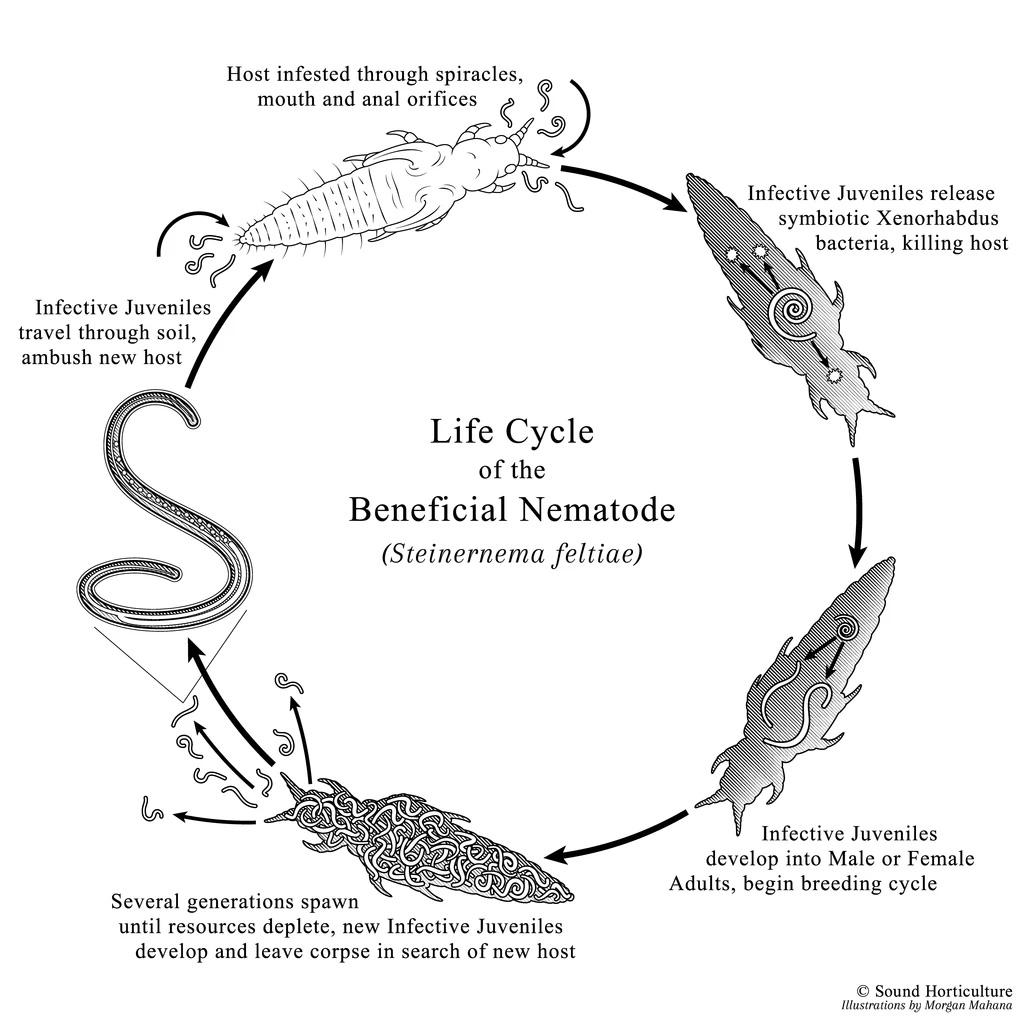EPNs 101: Controlling Crop Pests with EPNs and the EPN Life Cycle

Our resident EPN expert, Sadie McCracken, has big, big plans to research EPNs for biological control vegetable pests while pursuing her master's degree at UNH! We've convinced her to provide us with some basics starting with this introduction.
Our first post was an introduction to beneficial nematodes – aka: entomopathogenic nematodes (EPNs). Now that we know what EPNs are, it’s time to learn more about which pests they control, and how they control them.
Which species of EPN should I apply to my crop?
The answer to this question depends on the pest you are targeting. Identifying your target pest is the most important factor when considering which type of EPN to use.
There are many resources online that offer pest identification guides, such as the The Northeast Vegetable and Strawberry Pest Identification Guide. If you’re not so confident in your insect identification skills you can also send a specimen into our lab for assistance. Once you have positively identified your target pest you can decide which species of EPN to apply.

Although there are around a dozen species of EPNs that are produced commercially, there are just three main types that are most commonly used in the US. As you can see in the table above, each species of nematode controls a wide range of insect pests. The only catch is that EPNs only attack the soil-dwelling life stage of insects. Luckily, most insects have at least one part of their life cycle that occurs in the soil. Timing your application so that it aligns with the soil-dwelling stage of your target pest is crucial to the success of your treatment.
When do EPNs attack insect pests?
The larval or pupal stage of many insects develop in the soil, making them easily accessible and vulnerable to infection from EPNs. For example, to treat Japanese Beetle (aka: white grub) you need to apply your EPNs in the spring, when they are still just grubs – well before you would notice the adult beetles later in the summer. If it’s later in the season and you’ve already noticed a large adult population of your pest, you may need to combine your EPN application with other measures (such as cultural controls or a pesticide application) to adequately prevent damage to your crop.
For a quick (and fun!) overview of the life cycle of EPNs and how it allows them to kill insects check out this video.
How do EPNs infect their host?
EPNs seek out insects in the soil and enter their bodies through natural openings – such as the mouth. Once they are inside of an insect, they release bacteria from their digestive tract. Within a couple of days, the insect will die. The infected insect’s cadaver provides the perfect environment and food source for the EPNs to mature into adults and reproduce. Within a few days of the insect’s death, infective juvenile nematodes will emerge from the cadaver and begin searching for new hosts in the soil.
As you can see in Figure 1, EPNs parasitize the insect, but they don’t act alone when it comes to killing their host. It’s actually the combined impact of infection by the EPN and their symbiont gut bacteria that is the ultimate cause of insect mortality.

How long will the EPNs continue to control insect pests?
In general, EPNs will persist in your soil for several weeks after application, as long as they can find a new host. The exact amount of time varies depending on environmental conditions, the species of nematode, the population density of host insects and your application rate of EPNs. Under ideal conditions, the EPNs will infect and kill so many insects that there will no longer be enough hosts for them to sustain their reproductive needs. At this point your EPNs will have done their job – they will have significantly reduced the population of your target pest and prevented damage to your crop.
Additional Resources:
This overview on EPNs from The University of Florida goes into more depth about the nematode life cycle as well as host pests:
For a more detailed list of insect pests and which species of EPN to use to control them, visit this link.
For a more comprehensive introduction to EPNs, what pests they control, and a list of suppliers check out Cornell University’s Guide to Biological Control: Nematodes
